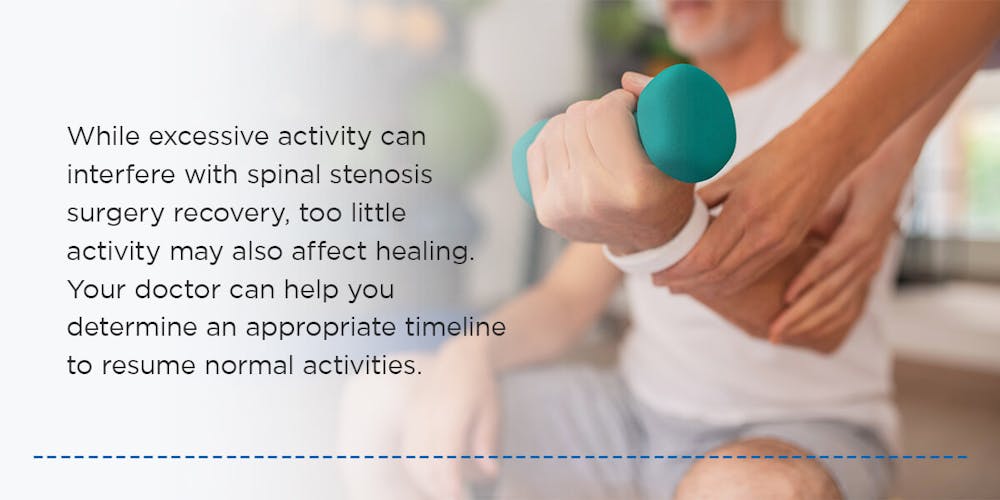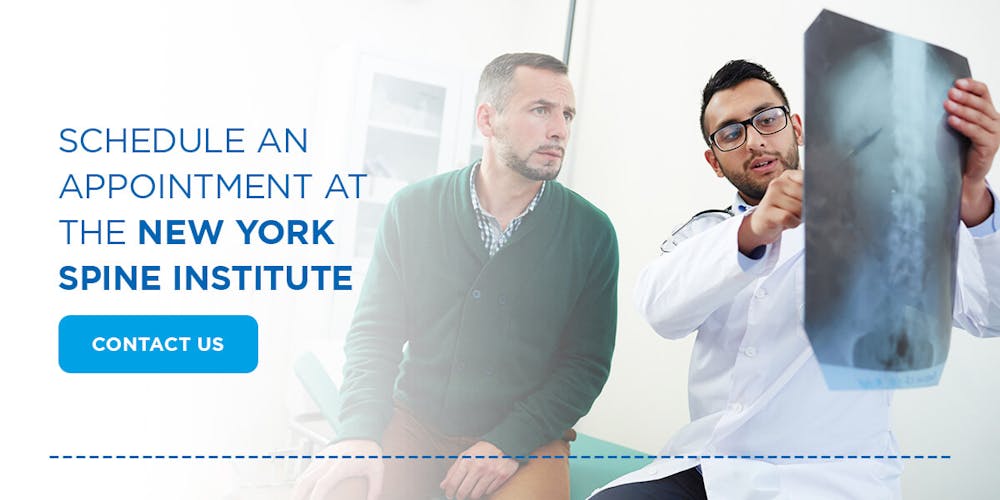Your spinal bones, which run from the skull to the tailbone, play a vital role in protecting the spinal cord. They provide structure and support for the body, enabling you to move and bend comfortably. When the spaces between the spinal bones begin to contract, the spinal cord and nerve roots compress, resulting in a condition called spinal stenosis.
As you can imagine, spinal stenosis puts immense pressure on the spine and makes regular movement far more difficult. Thankfully, there are multiple surgical and non-surgical options for treating this condition.
Here’s your complete guide to spinal stenosis, including causes, treatment options and expected recovery time after spinal stenosis surgery.
What Is Spinal Stenosis?
Spinal stenosis occurs when one or more of the spaces within the spine start to narrow, reducing space for nerves to travel through the spine. While it’s more likely to occur in older individuals, younger people with scoliosis or other spinal conditions can also be at risk of developing spinal stenosis.
The two main types of spinal stenosis are:
- Lumbar stenosis: Narrowing occurs in the lumbar region, or lower back. Lumbar stenosis is the most common type of spinal stenosis.
- Cervical stenosis: Narrowing occurs in the neck.
Treatment methods vary depending on the severity. Depending on the location of the spinal stenosis and how much it narrows over time, the compression of the spinal cord or a spinal nerve can cause muscle tingling, pain, numbness or weakness. Severe cases of spinal stenosis may cause problems with bowel or bladder function. While these symptoms can worsen over time, some people don’t experience any symptoms of spinal stenosis.
What Causes Spinal Stenosis?
Some individuals are born with small spinal canals that lead to spinal stenosis. However, spinal stenosis typically occurs when another condition reduces the amount of space within the spine. The following factors can cause spinal stenosis:
- Herniated discs: Discs are rubbery cushions that absorb shock between the spinal bones. When the disc dries out, it can crack and leak out soft inner material, which puts pressure on the spinal cord and nerves.
- Bone spurs: Conditions like arthritis and Paget’s disease of bone can cause additional bone growth on the spine. These growths, known as bone spurs, can move into the spinal canal.
- Tumors: While rare, tumors can develop within the spinal canal and cause spinal stenosis.
- Thick ligaments: The cords that help hold the spinal bones together can sometimes thicken and stiffen over time. These thick ligaments can push into the spinal canal.
- Spinal injuries: An automotive accident or other trauma can break or dislocate spinal bones. The swelling of nearby tissue following back surgery may also place pressure on the nerves or spinal cord.
Treatment Options for Spinal Stenosis
A doctor might suggest one or more of these treatment options before turning to surgery:
- Pain relievers: Over-the-counter medications like ibuprofen or acetaminophen may help ease your pain.
- Cortisone: Your doctor may inject a steroid called cortisone into your spinal column. This injection can bring either short-term or permanent relief.
- Exercise or physical therapy: Your doctor may recommend exercises or physical therapy treatment sessions to strengthen your back and stomach muscles, relieve pain and improve walking ability.
Many patients respond well to non-surgical methods like medication. However, certain instances may require spinal stenosis surgery, such as:
- Severe long-term pain, tingling and numbness in the arms or legs.
- Unsuccessful non-surgical treatments.
- Reduced motor strength or lost sensation in your legs or arms.
- Loss of bladder or bowel control.
What Is Spinal Stenosis Surgery?
Spinal stenosis surgery helps reopen the spinal canal. It aims to decompress the spinal cord or nerve to restore function and stimulate healing. There are three main types of spinal stenosis surgery:
- Laminectomy: A surgeon removes the bone, ligaments and spurs causing pressure on your nerves. They can either make one large cut — known as open surgery — or perform minimally invasive spinal stenosis surgery involving several small incisions, using lights and small cameras to see inside the body.
- Spinal fusion: A spinal fusion joins the vertebrae together to decrease movement within the spine. The surgeon may use metal rods or screws to fuse the vertebrae until a new bone grows between them. Alternatively, they may retrieve bone from another area to stimulate new growth. Spinal fusions sometimes accompany laminectomies.
- Foraminotomy: A surgeon extends the part of the vertebrae where nerves branch out to the rest of the body through an exit called the foramen. In other words, a foraminotomy enlarges the foramen opening so the nerve can exit without being compressed. This procedure is less invasive than a laminectomy but is not usually sufficient for more widespread and extensive spinal stenosis.
What to Expect When Recovering Spinal Stenosis Surgery
The hospital will likely discharge you to begin recovery two or three days after your surgery. It’s important to limit certain activities like bending, twisting, lifting heavy items and driving. Avoid activities that can hinder recovery, like housework, yardwork, exercising and smoking. Your physician will cover a list of activities you can and cannot do to ensure a smooth, successful recovery process.
Try to avoid sitting for long periods as well. While excessive activity can interfere with spinal stenosis surgery recovery, too little activity may also affect healing. Your doctor can help you determine an appropriate timeline to resume normal activities.
Depending on the extent of your surgery and restrictions after your operation, your doctor may also recommend physical therapy. Physical therapy typically runs two or three times a week for four to six weeks. Your physical therapist and doctor will determine if additional sessions are necessary after this time frame.
When You Can Expect to See Results After Having Spinal Stenosis Surgery
Your pain and swelling will likely start to decrease within the first few weeks after your spinal stenosis surgery. After about four to six weeks, most people can comfortably return to work without their prescribed pain medications. Just be gentle with movement and let pain be your guide.
Schedule an Appointment at the New York Spine Institute
If you think you may be dealing with spinal stenosis, our team at the New York Spine Institute on Long Island can assist you. Specializing in various orthopedic and spine conditions, we’ll help you create a customized care plan so you can receive the treatment necessary for recovery.
We offer a range of specialized services, from pain management to neurosurgery to physical therapy. Our diagnostics and treatment options can help relieve spinal stenosis symptoms, starting your journey to recovery so you can resume your normal activities and lifestyle. Contact us online today to learn more about our services or schedule an appointment.


